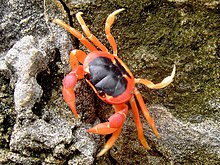Land crabs
| Land crabs | ||||||||||||
|---|---|---|---|---|---|---|---|---|---|---|---|---|

|
||||||||||||
| Systematics | ||||||||||||
|
||||||||||||
| Scientific name | ||||||||||||
| Gecarcinidae | ||||||||||||
| MacLeay , 1838 |
The land crabs (Gecarcinidae) are a family from the suborder of the crabs (Brachyura) within the decapod crabs (Decapoda) and live with around 20 species in tropical coastal regions. They are exclusively land animals that only visit the sea to lay their eggs and whose larvae develop in the sea.
To the land crabs include the Christmas Island red crab ( Gecarcoidea natalis ) on the Australian Christmas Island , Central American Halloween Crab ( Gecarcinus ruricola seem ), the West African Harlequin shrimp ( Cardisoma armatum ) that lives in coastal palm forests and the spread from Florida to Brazil Cardisoma guanhumi (it is up to 8 kilometers from the sea). During the day, land crabs live in caves under mangroves or in deep, self-dug holes, which in some species reach the groundwater . They prefer to eat plants and carrion and look for their food primarily at night or at dusk.
description
The gill cavity of the land crabs is supplied with moisture by a thin-skinned water sac and has taken on the function of a replacement lung.
Reproduction
The mating of the land crabs takes place on land. Only the females migrate to the sea to deposit the hatching larvae. These live in the sea for a few weeks and migrate to land after their metamorphosis. In the first time they are very hidden only in particularly humid places, as the gills have to adapt first.
ecology
Due to their diet and way of life, the land crabs occupy an important position in the ecosystem of the islands and coastal strips that they inhabit. By digging caves, they loosen the earth and, similar to earthworms in other regions, accelerate the decay of leaves through their plant-based diet. As scavengers, they reduce the spread of vermin. On small islands, the land crabs at the top of the food pyramid can act as top predators .
A far unique in nature hydrostatic skeleton of gas and water, the land crab Gecarcinus lateralis in the phase after a molt on: After shedding the old tank the animals inflate using compressed gas in their intestines on. In this way, the body of the animal, also known as the Halloween crab , receives the necessary stability until its new shell, which is already fully developed under the old shell, but still too soft - has hardened sufficiently.
Systematics
The land crabs are unlikely to be a monophyletic group. Accordingly, some changes are still to be expected within the system. The land crabs are currently divided into four to six genera . Michael Türkay of the Senckenberg Research Institute divided the genus Gecarcinus into two subgenus in 1970 , whereby he of the subgenus Gecarcinus (Johngarthia) the three species C. planatus (Stimpson, 1860), C. malpilensis (Faxon 1893) and C. lagostoma ( H. Milne Edwards , 1837) assigned. In 1973 the subgroup of C. lagostoma distributed in the East Atlantic in the Gulf of Guinea was separated from the West Atlantic subgroup as a separate species C. weileri (Sendler, 1912). In 1987, Türkay raised the subgenus he had established to a separate genus under the name Johngarthia , in honor of the zoologist and crab researcher John Garth. The genus Discoplax was introduced by Alphonse Milne-Edwards in 1867 for the long-legged land crab Discoplax longipes . In 1987 Michael Türkay put two species of the genus Cardisoma , namely Cardisoma rotunda and Cardisoma hirtipes, also in the genus Discoplax . In 2001, Peter Ng and Daniéle Guinot described another species of this genus, namely Discoplax gracilipes .
- Cardisoma
- Discoplax
- Epigrapsus
-
Gecarcinus
- Gecarcinus lateralis , Halloween crab (Red Land Crab)
- Gecarcinus quadratus , Halloween crab
- Gecarcinus ruricola , Halloweenkrabbe (Purple Land Crab)
-
Gecarcoidea
- Gecarcoidea natalis , Christmas Island Crab
- Gecarcoidea lalandii ,
- Johngarthia
Individual evidence
- ↑ CD Schubart, S. Cannicci, M. Vannini, S. Fratini: Molecular phylogeny of grapsoid crabs (Decapoda, Brachyura) and allies based on two mitochondrial genes and a proposal for refraining from current superfamily classification . Journal of Zoological Systematics and Evolutionary Research 44 (3), 2006, pp. 193-199
